Last of two parts
OCRACOKE — I decided to complete the next part of my “Walking with Thoreau” expedition in mid-March. Gasoline prices had skyrocketed a few days before, so I did not feel right about asking anyone to drive me to my taking-off spot at the Pony Pens. Instead, I headed up N.C. 12 on my bicycle, anticipating a good workout and an enjoyable ride. It was both.
Supporter Spotlight
From my bike seat I had an excellent view of things not often noticed in my truck. Past the campground I noticed, to the west, tall dunes and a little path. I pulled over and hiked up to the top. From there I surveyed a world of miniature mountains folding into the distant Pamlico Sound — a sight that seemed quite remarkable to me. Thoreau wrote about how similar hills at Cape Cod were formed, saying: Beach-grass during the spring and summer grows about two feet and a half. If surrounded by naked beach, the storms of fall and winter heap up the sand on all sides, and cause it to rise nearly to the top of the plant… and continues to ascend… Sand hills formed in this way are sometimes one hundred feet high and of every variety of form, like snow-drifts, or Arab tents, and are continually shifting.
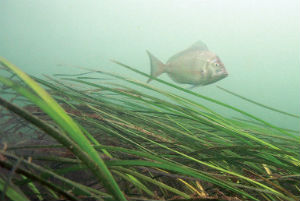 Thoreau describes “a grass-like seaweed (Zostera)” in his book “Cape Cod,” while Garber describes the eel grass (above) that is more commonly seen on Ocracoke Island. Photo credit: New England Boating |
A little farther on I noticed another path, and following it, I found myself on the shore of Pamlico Sound. Piles of grassy seaweed, known as eel grass, were tucked up against dead trees and other jetsam. In writing about Cape Cod’s western shore, Thoreau wrote that it was nearly as sandy as the eastern, but the water was much smoother, and the bottom was partially covered with the slender grass-like seaweed (Zostera), which we had not seen on the Atlantic side.
Back on the road, I pedaled into the parking area across from the pony pen, glancing over at the two horses that stood behind the fence. I allowed myself a moment of regret that the famed wild ponies of Ocracoke no longer ran wild, to be captured and ridden by the islanders. On his June 1857 walk at the Cape, Thoreau described a scene that was probably common on Ocracoke two centuries ago, when islanders transported ponies to Hatteras: Saw them swim three horses across from Saquish Head to the island, a quarter of a mile or more. One rows a small boat while a man holds the bridle. At first the horses swam faster than the man could row, but soon they were somewhat drawn after the boat.
Leaving my bicycle tucked behind a yaupon tree, I began walking. Before long I sat down on a small dune and, pulling out Thoreau’s book, read: Before the land rose out of the ocean, and became dry land, chaos reigned; and between high and low water mark, where she is partially disrobing and rising, a sort of chaos reigns still, which only anomalous creatures can inhabit.
I had been paying attention to that area between high and low water mark as I walked, where Thoreau’s chaos does indeed still reign. More specifically, I had been watching the formation and dissipation of sea foam — countless bubbles that each wave creates and hurls onto shore. Sometimes the bubbles left artistic patterns in the sand before the next wave washed them away. Thoreau referred to this froth when he wrote the following: The foam ran up the sand, and then ran back as far as we could see […] as regularly as the master of a choir beats time with his white wand.
Supporter Spotlight
It was Sunday, nearing 11 a.m. now, a time when many head for church. I am not a church-goer, nor am I affiliated with any formal religion, although I respect the beliefs of those who are. For myself, this great expanse of sand and sea is as holy a place as I could imagine, and I agreed with Thoreau, who wrote in that All genuine goodness is original and as free from cant and tradition as the air. It is heathen in its liberality and independence on tradition.
Walking farther down the beach, I glanced leeward, noting absently the row of telephone poles that stood at regular intervals along the island. Thoreau’s trek took place soon after a similar invention was installed on Cape Cod. He wrote, referring to a treeless area, that the new telegraph wires are a godsend to the birds, affording them something to perch on.
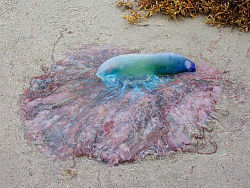 The tentacles of a Portuguese man-of-war can still deliver a painful sting even after they wash on shore dead. Photo credit: Jo O’Keefe |
As I neared the airport I came upon what looked like a small blue balloon, and I reached down to pick it up. Seeing it more clearly, I realized that it was not a balloon at all but a small Portuguese man-of-war — a colony of organisms, or a siphonophore, that looks like a kind of jellyfish and whose tentacles can retain their powerful sting even when dead and dried up, as this one was. Despite their sting, jellyfish are a favorite food of leatherbacks and other sea turtles. A hydrogen balloon, released at a birthday party and blown into the ocean, may look like dinner to a passing leatherback, but it is a death sentence as well. Sea turtle necropsies have, I knew, revealed alarming numbers of turtle stomachs stopped up and entwined with balloons.
Thoreau wrote about a similar topic in 1849: You might make a curious list of articles which fishes have swallowed,–sailors’ open clasp-knives, and bright tin snuff-boxes, not knowing what was in them,–and jugs, and jewels.
As I approached the Airport Ramp a new sound met my ears, and I watched a single-engine plane take off, flying close over my head. I wondered what Thoreau would have thought of that sight. I hiked across the ramp to the road, bidding farewell to the place where, in Thoreau’s words, A man may stand there and put all America behind him.
On the final day of my expedition, I set out to walk the southernmost part of Ocracoke Island. I rode my bicycle down South Point Road, passing through the vast expanse of saltmarsh that straddles both sides of the sandy lane. As the wind grew stronger and the sand softer near the road’s end, I gave up riding and walked my bike to a spot where I could lay it down behind a dune.
The road emerged here into a vast expanse of sand spreading in all directions and disappearing finally into the sea. The dunes and vegetation that reached nearly to the ocean farther up the beach were far away; the electric poles following the highway out of sight. Standing here, I could imagine myself in a great sand desert, and I compared this vista to Thoreau’s description of the great flats on Cape Cod, of which he said: All the aspects of this desert are beautiful, whether you behold it in fair weather or foul, or when the sun is just breaking out after a storm, and shining on its moist surface in the distance, it is so white, and pure, and level, and each slight inequality and track is so distinctly revealed; and when your eyes slide off this, they fall on the ocean.
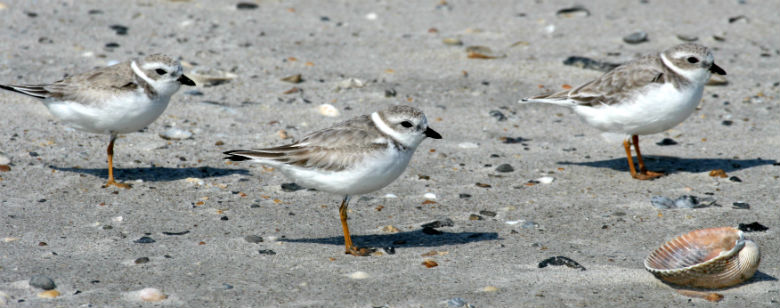 Thoreau frequently mentioned these little shorebirds in his book, “Cape Cod”: “If I were required to name a sound, the remembrance of which most perfectly revives the impression which the beach has made, it would be the dreary peep of the piping plover.” Photo credit: Sam Bland |
The beach here was marked with a few tire tracks, as this was a favorite area for surf-fishing, and even this early I saw a few fishermen with their lines out. Further up, however, was a zone that was closed to traffic because of nesting shore birds. The signs were reminders that this was a national seashore, and that there were angry debates going on about driving on these beaches and its impact on their wild inhabitants. The creature that caused most of the stir was the piping plover, which is listed under the Endangered Species Act as a threatened. Thoreau frequently mentioned these little shorebirds in his book, saying that … if I were required to name a sound, the remembrance of which most perfectly revives the impression which the beach has made, it would be the dreary peep of the piping plover.
Thoreau wrote that the seashore is a sort of neutral ground, a most advantageous point from which to contemplate this world. As I watched the waves roll in, I was reminded of the images I had seen on CNN of the tsunami that had devastated northern Japan. When the waves approached, I simply walked higher up on the beach to avoid soaking my shoes. That option had not been available to the thousands who died in that tragedy.
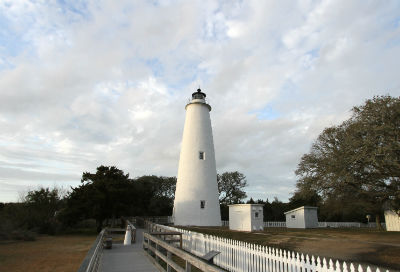 The Ocracoke Lighthouse, built in 1823, is a favorite attraction on the island. Photo credit: Sam Bland |
Thoreau’s words, written in 1849, described what that ocean could become: […] this same placid ocean, as civil now as a city’s harbor, will erelong be lashed into sudden fury [...] It will ruthlessly heave these vessels to and fro, break them in pieces in its sandy or stony jaws, and deliver their crews to sea monsters. This gentle Ocean will toss and tear the rag of a man’s body like the father of mad bulls, and his relatives may be seen seeking the remnants for weeks along the strand.
Through the sand hills I glimpsed one of Ocracoke’s favorite attractions, the Ocracoke Lighthouse, built in 1823. Thoreau took note of the lighthouses he saw on Cape Cod, and spent a night at the Highland Light, built in 1798. He described accompanying the lightkeeper on his rounds: At rather early candle-light he lighted a small Japan lamp […] and told us to follow him. He led the way first through his bedroom […] then into the lower part of the lighthouse […] thence we ascended by a winding and open iron stairway, to a trap-door in an iron floor, and through this into the lantern.
A few yards farther on I saw a plastic water bottle lying in the sand, dropped perhaps in carelessness or tossed out an SUV window. Plastic bottles may, like balloons, entice sea turtles or fish to eat them. Otherwise, they may become part of the huge plastic masses that float like dead continents in the ocean. Thoreau spoke of finding a bottle at Cape Cod in 1849. His bottle would have been made of glass.
I picked up a bottle half buried in the wet sand, covered with barnacles, but stopped tight, and half full of red ale, which still smacked of juniper,–all that remained I fancied from the wreck of a rowdy world […] but as I poured it slowly out onto the sand, it seemed to me that man himself was like a half-emptied bottle of pale ale, which Time had drunk so far, yet stopped tight for a while, and drifting about in the ocean of circumstances, but destined erelong to mingle with the surrounding waves, or be spilled amid the sands of a distant shore.
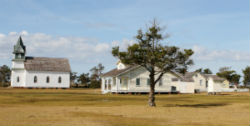 Portsmouth Island, which can be seen from the southern tip of Ocracoke Island, has a ghost town preserved in Cape Lookout National Seashore. Photo credit: Sam Bland |
The crash of surf was less distinct here, the waves lower and longer. I was approaching Ocracoke Inlet, the channel that separates Ocracoke from Portsmouth Island, where a busy town once bustled with life. Now it is a ghost town, preserved as part of the Cape Lookout National Seashore, its prosperity destroyed when violent storms caused the inlet to silt up and ship traffic went elsewhere. I wished to dip my toes into the waters of that inlet before turning back, and, in Thoreau’s words, to see that seashore where man’s works are wrecks […] where the ocean is land-lord as well as sea-lord, and comes ashore without a wharf for the landing; where the crumbling land is the only invalid.
It was with shock, therefore, that I realized that the previously mentioned no-trespassing fence had curved around to close off the beach before me. I would not be able to complete my walk to the end of Ocracoke. I did not begrudge the piping plovers their safe nesting grounds, but I felt somehow cheated. I turned around and, now pressing into a strong wind, headed back along the beach to South Point Road. Stopping one last time, I stared out across the ocean, a wilderness reaching round the globe, wilder than a Bengal jungle.
Then, collecting my bicycle, I went home, far the richer for the time I had spent walking with Thoreau.







